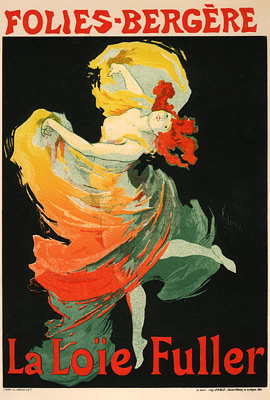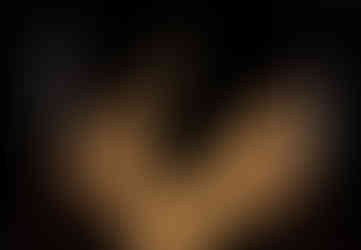- Mary Hazel

- May 24, 2020
- 4 min read
Long, billowing sleeves and genius, technical innovation

Affiche Publicitaire de Loïe Fuller, Raymond Tournon, 1901
Growing up as a ballet dancer, I never had a chance to explore other dance genres. Why? Well...I haven't got a clue. In all honesty, I was the one to refuse to take any other dance class besides ballet for ten years. But, jeez, do I regret it. After seeing the wonderful dancing of Loïe Fuller, I wish I could turn back time and explore with a more modernist approach.
Who is Loïe Fuller? If her name does not sound familiar, I'm sure her image will resonate with some deep forgotten memory. Take a look at the artwork below:
(First, Left) Affiche:Folies Berger: La Loïe Fuller, Jules Chèret, 1893
(Second, Right) Serpentinentänzerin, Koloman Moser, 1902, Pencil and Watercolor on Paper, 28.8 × 45.3 cm, Albertine Collection
Loïe Fuller, born Marie Louise Fuller, was born in Hinsdale, Illinois (formally the Chicago suburb of Fullersburg during her time) in 1862. She began her career as a child actress and then moved onto burlesque, vaudeville, and shows in the circus. Fuller utilized the free dance movement to escape from the rigid conformity of ballet, described as being a dance of natural movements and improvisation. Experimental and innovative, she began to deviate from the established dance styles of the day and developed her own styles, particularly in light effects.
Her first encounter with special effects was in her skirt dance numbers. Skirt dances originated in London and mostly performed in burlesque or vaudeville stages. A dancer uses a large, layered skirt as part of her routine - one notable skirt dance is the Can-Can. These skirts could go into extreme lengths, some garments reaching up to 100 yards in fabric.
Fuller utilized this dance genre to showcase a new height of modernity. You see, in the mid-1880s, electric lighting was slowly being introduced to theaters and stage productions. However, no one really ventured into using lights as a new art form except for Fuller. She used long skirts and lighting to play with its reflective properties and emphasize the form in shadows. This soon developed further into her signature style by 1891, mixing flowing silk costumes and colored lighting later called the Serpentine Dance.
Unfortunately, she had quite a bit of trouble finding a theater to produce her work but soon was hired to perform between numbers in the comedy, Uncle Celestine. And this was a big hit. All roads to greatness are never easily received, she began to have massive imitators taking up her name and riding on her artistic coattails. This is when she decided to move to Europe in 1892.
Paris embraced her with incredible warmth and applause, being the famous home of the avant-garde in the 19th century. Fuller would be hired as a regular performer at the Folies Bergère and create memorable pieces like Fire Dance. As her costumes became more and more daring, increasing to astronomical lengths, Parisian visual artists considered Loïe Fuller as a muse and the epitome of the Art Nouveau movement. Sweeping lines, soft coloring, dramatic yet natural flare - Henri de Toulouse-Lautrec, Auguste Rodin, Jules Chèret, and others amongst their ranks used her form as a basis of their pieces.
And she continues to be a legend even till today. Did you know that she has several U.S. patents for her stage lighting? In order to create the colored stage lighting that defined her iconic choreography, Fuller used color gels and chemical salts to illuminate her garments. She also attempted to patent her own dance style because of the huge amount of imitators but the US Copyright Office rejected her request, stating that the work had no clear narrative, therefore, it cannot be protected. Keep in mind, this was during the time where modern dances were seen as too abstract to the general public.
It is an incredible shame that Fuller was never a part of silent films. The video below, which illustrates what her dances would look like, is not her. However, it does illustrate her impact and influence in the modern dance world.
Title: Film from 1901, based on Loïe Fuller's dance
Author: Unknown author. Some copies have been stencil-colored in Segundo de Chomon's Barcelona workshop in 1902.
Date:1901
To see a contemporary version of her dance (and what it would most likely have looked like back then), I would suggest hopping on YouTube and watching Jody Sperling. She is choregrapher based in NYC, specializing in vintage, "lost" dance styles with her company, Time Lapse Dance. Her work is breathtaking and she even choreographed for the film La Danseur, a French film based on Loïe Fuller's life.
I truly wish I could time travel to see Fuller's dancing! I can only imagine how magical it must have been to an audience who had never seen colored lighting before. I hope the art form continues to live and I get to see Jody Sperling and her troupe perform after lockdown.
And that's art.
Afterthought
I will be examining how the effects of Fuller's dance is made possible with the various elements included in her choreography. This will be on our Instagram story but I will post screenshots on this blog post afterward. Stay tuned!
From our Instagram Story
Public Domain in the US



















